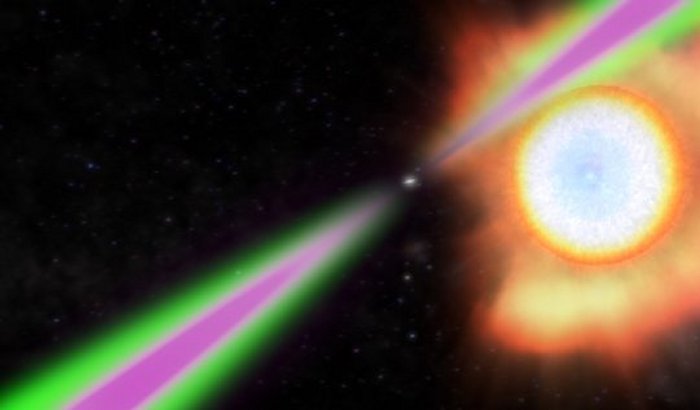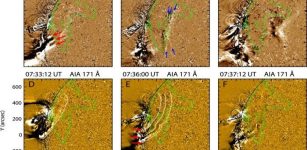Fastest Spinning Radio Pulsar J0952-0607 Has A Companion And Emits Pulsed Gamma Rays
Eddie Gonzales Jr. – MessageToEagle.com – The radio pulsar J0952-0607 rotates 707 times in a single second and is, therefore, the fastest spinning in our Galaxy outside the dense stellar environments of globular clusters.
It also emits pulsed gamma radiation, according to a new study.
 A black widow pulsar and its small stellar companion, viewed within their orbital plane. Powerful radiation and the pulsar’s “wind” – an outflow of high-energy particles — strongly heat the facing side of the star to temperatures twice as hot as the sun’s surface. The pulsar is gradually evaporating its partner, which fills the system with ionized gas and prevents astronomers from detecting the pulsar’s radio beam most of the time. Credit: NASA’s Goddard Space Flight Center/Cruz deWilde
A black widow pulsar and its small stellar companion, viewed within their orbital plane. Powerful radiation and the pulsar’s “wind” – an outflow of high-energy particles — strongly heat the facing side of the star to temperatures twice as hot as the sun’s surface. The pulsar is gradually evaporating its partner, which fills the system with ionized gas and prevents astronomers from detecting the pulsar’s radio beam most of the time. Credit: NASA’s Goddard Space Flight Center/Cruz deWilde
PSR J0952-0607 was first discovered in 2017 by radio observations of a source identified by the Fermi Gamma-ray Space Telescope as possibly being a pulsar.
Using NASA’s Fermi Gamma-ray Space Telescope, and LOFAR radio observations from the past two years, and gravitational-wave data from the LIGO detectors, Lars Nieder, a PhD student at the AEI Hannover, set out to see if the pulsar also emitted pulsed gamma rays.
No pulsations of the gamma rays in data from the Large Area Telescope (LAT) onboard Fermi had been detected. Observations with the radio telescope array LOFAR identified a pulsating radio source and – together with optical telescope observations – allowed to measure some properties of the pulsar. It is orbiting the common center of mass in 6.2 hours with a companion star that only weighs a fiftieth of our Sun.
“Our search found a signal, but something was wrong! The signal was very faint and not quite where it was supposed to be. The reason: our detection of gamma rays from J0952-0607 had revealed a position error in the initial optical-telescope observations which we used to target our analysis. Our discovery of the gamma-ray pulsations revealed this error,” Nieder explained in a press release.
“This mistake was corrected in the publication reporting the radio pulsar discovery. A new and extended gamma-ray search made a rather faint – but statistically significant – gamma-ray pulsar discovery at the corrected position.”
No pulsations of the gamma rays in data from the Large Area Telescope (LAT) onboard Fermi had been detected. Observations with the radio telescope array LOFAR identified a pulsating radio source and – together with optical telescope observations – allowed to measure some properties of the pulsar.
It is orbiting the common center of mass in 6.2 hours with a companion star that only weighs a fiftieth of our Sun. The pulsar rotates 707 times in a single second and is, therefore, the fastest spinning in our Galaxy outside the dense stellar environments of globular clusters.
PSR J0952-0607 has a companion star, which is most likely tidally locked to the pulsar like the Moon to the Earth so that one side always faces the pulsar and gets heated up by its radiation.
These observations raise new unanswered questions about this system.
While the radio observations point to a distance of roughly 4,400 light-years to the pulsar, the optical observations imply a distance about three times larger.
An explanation for this discrepancy might be the existence of shock waves in the wind of particles from the pulsar, which could lead to different heating of the companion.
More gamma-ray observations with Fermi LAT observations should help answer this question.
Read more – here
Written by Eddie Gonzales Jr. – MessageToEagle.com Staff










